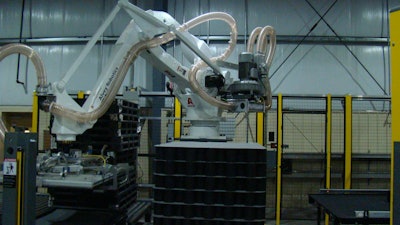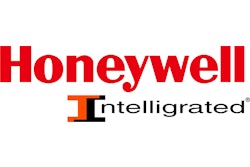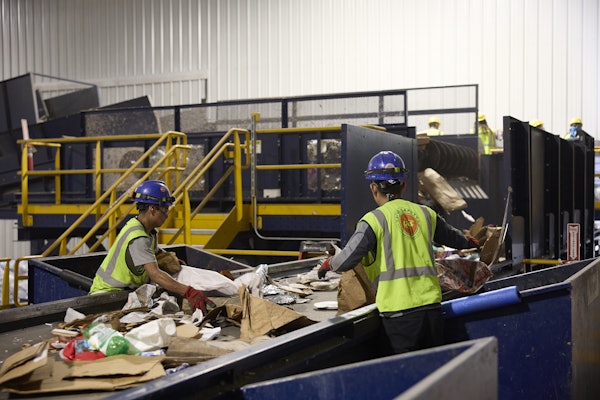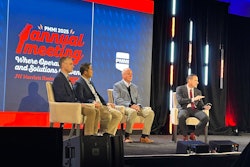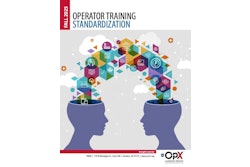For Axalta Coating Systems, headquartered in Philadelphia, the use of integrated robot and programmable logic controller (PLC) controls for the first two robots in its Front Royal, VA, facility provided the flexibility and ease of programming needed to help facilitate its transition to a new packaging automation system. Axalta is a leading global provider of liquid and powder coatings for automotive, transportation, industrial, architectural, and decorative applications, with 35 manufacturing centers, seven R&D facilities, and 42 customer training centers around the world.
In late 2012, when the company began specifying equipment for a new can filling line at the Front Royal plant, it turned to Intelligrated to supply empty can depalletizing and case palletizing equipment. Recalls Sam Saleh, Sales Engineer for Intelligrated, “We were asked to take a look at this in a conventional palletizing way. But because of space constraints, eventually it evolved into a robotic palletizing operation.”
According to Axalta Electrical and Controls Engineer John White, space had never been a challenge for the 30-year-old Front Royal plant before, so conventional palletizing and depalletizing were the norm. “However, this new line was designated for an area with restricted space, so robotics became a viable alternative,” he says.
Among the requirements for the new systems were flexibility to handle a range of can sizes and case weights; operating speeds in excess of the line’s filler speed (proprietary); and elimination of silicone in the robots’ end-of-arm tooling (EOAT). As White explains, car paint does not react well with silicone, so all of the system’s pneumatic, vacuum, and blower components and can-handling surfaces had to be silicone-free.
In addition, White says, Axalta was very focused on having “a high-reliability machine, with minimal operator interface so that the operators could spend their time interfacing with the actual filling operation.”
To meet Axalta’s needs, Intelligrated installed two Yaskawa Motoman four-axis MPL300 robots, featuring a 300-kg payload and fast axial speeds and acceleration that reduce cycle times and increase production output.
Notes White, the key advantage of the systems is the way the controls are designed: “The systems take advantage of the MLX100 robot control platform from Motoman that provides an interface between the robotics control system and the PLC so that all of the programming can be done on a familiar Allen-Bradley system [from Rockwell Automation] using RSLogix® software instead of having both a Yaskawa interface and an Allen-Bradley interface for technicians to handle. It just makes the troubleshooting easier for our technicians, who are familiar with the Allen-Bradley platform.”
With a traditional robot controller, programming and control of the robot is done with a proprietary robot language—in the case of Motoman’s DX100 controller, it would be INFORM (Instructions for Motoman)—while the rest of the peripheral equipment is programmed and controlled through the PLC. “With MLX100, the system becomes much more maintenance-friendly, and easy to use and debug in case of any problems,” White says. “It also allows for a significant level of flexibility in our safety control system by using Allen-Bradley’s safety-rated PLC. We can have things shut down and start up in the way we want. It makes it easier for our operators, while still maintaining the level of safety that we need.”
Also suited to Axalta’s requirements, Saleh explains, is the depalletizer’s ability to initialize depalletizing of a partial load or partial layer of cans with the layer handling tool, to minimize waste in packaging and assist operators with container size changeovers. The robot uses a vacuum EOAT designed by TEPRO, while a clamp tool from Intelligrated is employed for the case palletizer.
Since installation in August 2013, the few problems encountered, White says, have been primarily related to the operations and support personnel’s learning curve and have been “quickly and professionally” addressed by Intelligrated. And, he adds, the installation has provided the hoped-for hands-off operation: “The two robotics systems together have less operator interface than any other pieces of equipment. They just sit there and run.”
Axalta now has a growing appreciation of robotic systems capabilities. “Robotics is a resource we will continue to leverage for future manufacturing applications,” says White.
The company’s appreciation of robotics and innovation has also extended to its support of educational opportunities for students, with its sponsorship of a team near its North American headquarters, The Miracles of Engineering (MOE), a part of First State Robotics. As White explains, First State Robotics is a Delaware nonprofit that fosters a love of science and technology by engaging students in the engineering design process and in robotics competitions. Axalta is also forming a partnership with Texas A&M College of Engineering that includes an internship program.
Learn more about the MLX100 Robot Gateway.
This article is part of the August 2014 Robotics & Automation Special Report. See the full story.
